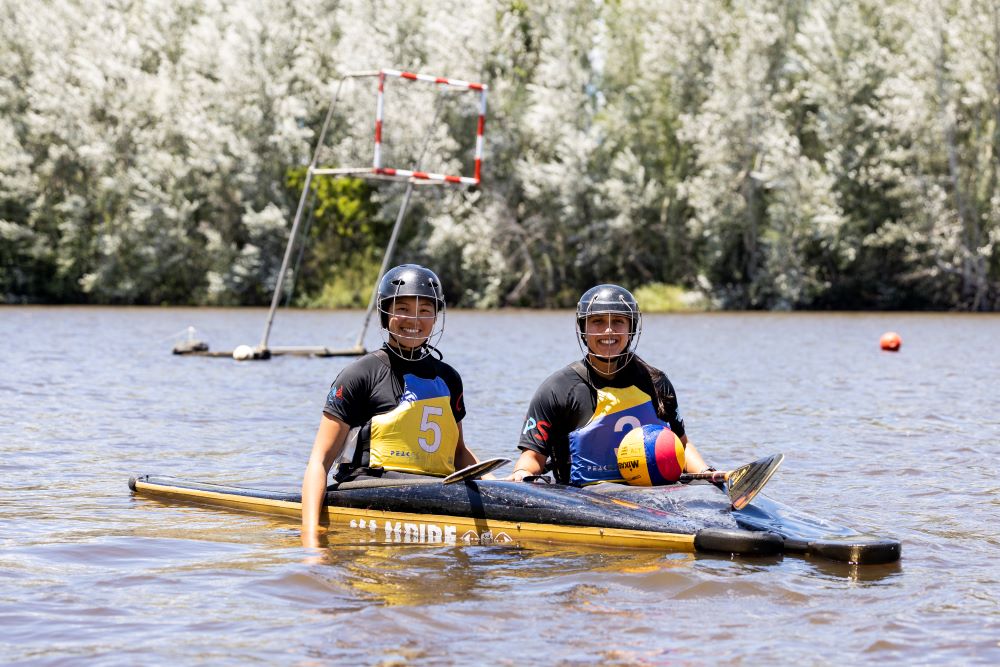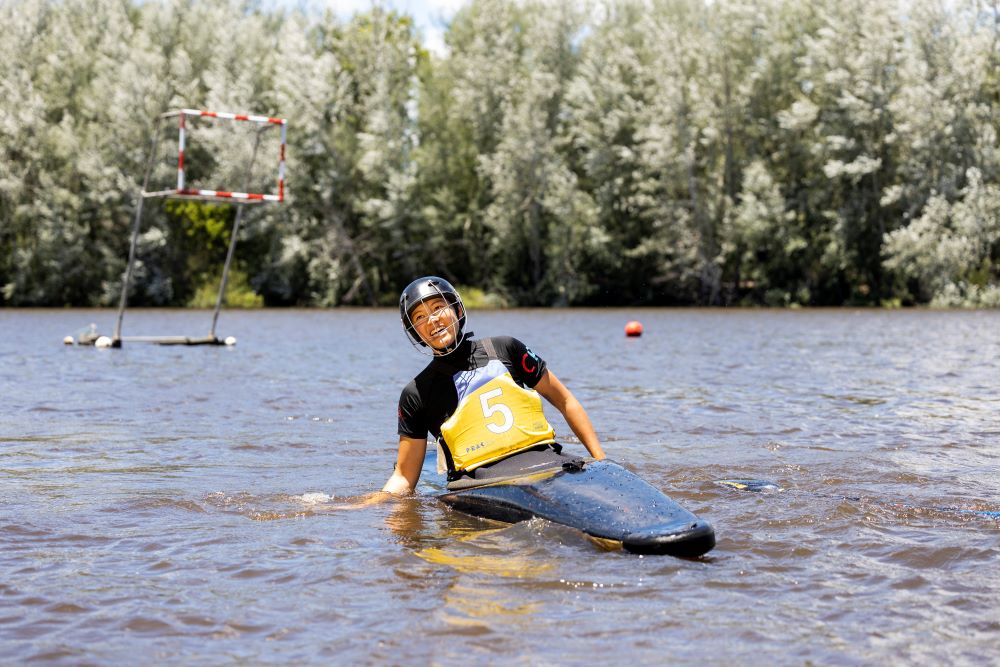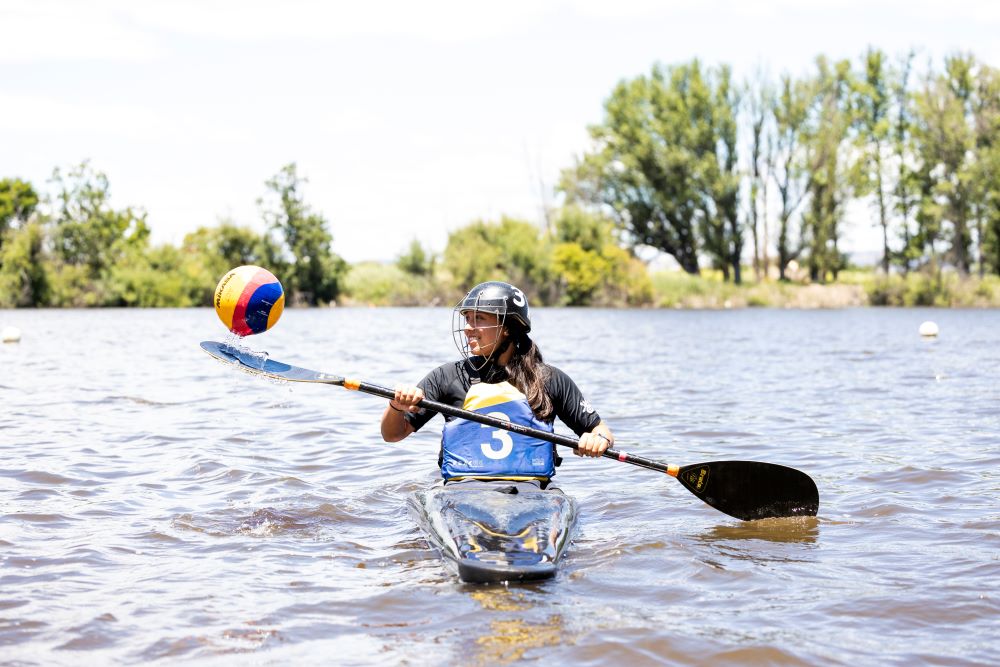It’s time to put the horses in the paddock, ditch the mallet, and pick up a kayak. Polo has a new look. The Sport of Kings has been reimagined to be played in the water before, but canoe polo sees the game being played on top of the water, in a much more physical variation.
“Australia was, back in the ´90s, one of the founding countries where polo grew from; and for some reason here and New Zealand, they call it canoe polo, whereas in Europe, it’s kayak polo,” says Laura Kleinrahm, canoe polo convener for the Burley Griffin Canoe Club.
Like the traditional sport, canoe polo was born in England; a paper was captioned “Polo on the Sea” back in 1875. However, the sport as we know it now can be attributed to the demo event at the National Canoe Exhibition in London in 1970.
The canoes, actually purpose-built kayaks, are smaller, lighter, and bounce back from contact much more easily. That’s right, canoe polo is a contact sport, something many players don’t realise when they sign up.
“When I started, I was thinking you have a three-metre-long shield around you, less contact,” player Cathy Gao says. “But then you find that you’re locked into the boat … if someone hits you at the very tip of your boat, you’re going to feel that through the rest of it.”
Cathy’s partner encouraged her to join the club in February 2022 after the pair went on a sea kayaking trip.
Laura discovered the contact sport at just 14 years old after a friend invited her to come along; she fell in love with it, and has been improving her game for the past nine years. When she moved to Canberra, she was keen to find somewhere to play here.


Canoe Polo ACT falls under the banner of the Burley Griffin Canoe Club (BGCC), which has around 200 members, of whom around 40 are involved with the sport. The core group of players numbers about 20, with 10 members regularly travelling interstate for competitions.
When playing, each team consist of five people battling against the opposition players to score goals in the hoops above the water. The game begins with a charge start: a member is chosen from each side to reach the ball first, often colliding or ‘tackling’. Tackling is often more strategic than just ramming an opponent.
“The idea is that you have enough control that you can get under a boat, and then you can move them around. It’s not necessarily a head to head; you are trying to use some skill to get under them,” says Cathy.
The team tries to make it to their end of the field where the opposition goalie is there to block the shot. The women say there are no set positions like there are in something like netball; however, some players are more drawn to the position.



In her short time with the team, Cathy has been perfecting her roll, which is used when a player from the opposing team pushes you, flipping over the kayak.
The vigorous sport requires players to remain in shape, and the team trains all year round. During daylight saving, they play at Molonglo Reach, and then switch to Tuggeranong Pool for the cooler seasons. However, a few dedicated members can be seen practising in the Reach on cold, dark, winter nights.
“It would be cool if we could eventually get some better lighting systems up here, because we can train under the bridge for a little bit, but otherwise, it is pretty dark and miserable in winter,” Laura says. “We are definitely enjoying the long summer nights!”
There are different grades within the team. A-grade players often travel interstate for competitions. This level is mainly comprised of men, which the pair says is due to the physicality of the game.
Cathy and Laura both play B-grade, but Laura has played A-grade for a couple of interstate competitions. They play local comp games each week, then during the season, they compete in seven competitions, including the nationals.
The ACT men’s nationals team is a safe bet to be in the top three; they secured their first gold earlier this year. The women’s team used to do well in the nationals until many members moved away.
“We’re probably the most active women’s team in Australia in terms of numbers and participation,” Laura says. “But we’re just working on the results side of things.”
Some of the ACT members have also played on the world stage. Laura went to the 2018 ICF Canoe Polo World Championships in Canada with the team back in 2018. She made the team again in 2020, but the event was cancelled due to the pandemic. COVID also kept the Aussie team away from this year’s competition.
“2024 will hopefully be a good chance for Australia to get back to it,” Laura says. “Australia was really strong in the ‘90s and helped introduce the sport to New Zealand; they are now really strong.”
BGCC will host the final of the summer series events on Lake Burley Griffin on 25 and 26 February. Players from across the country, from both national and developing skill levels, will battle it out for a title.
Along with the fitness and the competitiveness of the sport, Cathy says it is the community which has been built that keeps her returning, something Laura says they have been working hard to create.
“It’s like you come here, you paddle, you stay behind, maybe have a few beers, have a yarn,” says Cathy.
“People come here who are looking for that social aspect compared to other members of the club who might just be looking to paddle,” Laura says. “We really prioritised growing that community.”
For the last few years, they have worked on making the demographic of the club more inclusive. Laura says it has always been fun, but with a more diverse mix of members, it really has a community feeling. Now people in their 20s and 30s make up the majority, while the gender spilt is about 50/50.
“It used to be quite pale, stale, male,” Laura smiles. “It was 50-year-old dudes with a little smattering of women … Now we’ve got players from 17 through to the oldest player is around 60.”



Think canoe polo might be for you? While you don’t need to be a proficient swimmer, you do need to have confidence in the water, as you will be spending time upside down, and staying calm is a necessity. Having some experience with a kayak, polo, or basketball will be an advantage, as will a baseline level of fitness. That being said, the club welcomes people of all fitness levels.
“It’s quite a hard sport to start off with, because there’s a lot going on, but then that does make it more rewarding,” says Laura.
Going straight from couch potato to canoe polo star may be a bit difficult, as you will have to spend a bit of time floating in the water to build up core muscles. The BGCC has a mini gym set up for people to help build their fitness levels. Laura says the women have gym sessions each week together, but members can access it whenever they like.
The BGCC yearly membership will set you back $160, and $190 for new members. The gear is where the costs start to add up: the kayaks cost upwards of a few thousand dollars, then there are paddles, a life jacket, and a helmet. You don’t need to commit to everything up front. When travelling, the team reduces costs by driving, camping, and sharing accommodation.
“You get access to the club’s gear, so you don’t actually need to purchase your own equipment until you’re wanting to upgrade,” Laura says.
Their biggest piece of advice would be to get in and give it a go while the weather is still hot.
“Summer is an excellent time because falling in is much less scary; it’s nice and warm, and everyone is happy,” smiles Cathy.
Put your skills to the test with Canoe Polo ACT; facebook.com/ACTCanoePolo
Canberra Daily is keen to hear from you about a story idea in the Canberra and surrounding region. Click here to submit a news tip.



